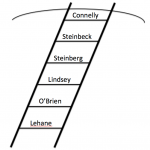Every adult can probably think back to a time when they were a kid standing along a wall praying to the dodge ball gods that you would not be the last one standing there! And if you can’t remember that feeling, just imagine standing in front of your 5th grade class in your underwear. It’s a similar feeling of humiliation. We all bear scars of some sort as we survived the battlefield that was our school career and these scars have formed us into the adults we are. In my copious free time, I play in an adult kickball league. One weekend, we picked teams based on old playground rules. Every one line up! This process led to some heated debates and discussions which have caused me to wonder about how we should group our students.
One of the biggest burdens I carry as a teacher is the fact that I can royally screw up one of my students and leave them with scars for life! However, I also want them to exit my classroom in May as a better, stronger person than when they entered my room in August. With this in mind, I use a variety of grouping strategies to try and bring out there best. Sometimes I let them decide. Sometimes it’s random and sometimes it’s up to me. I think it’s important to have a goal in mind when you choose how to group your students.
I seat my students in table groups and I do not ever let students pick their seats for instruction. I need to make sure that those who have trouble seeing or hearing are close to me. Also those who are easily distracted need to be in my direct line of vision so I can keep them on track. Students who are too talkative or do not get along are not next to each other because I want to make sure that there are no distractions or hindrances to the material that I am teaching. That’s part of my job to create an effective learning environment.
Group work, partner work, and games are different though. I don’t want to always make their decisions for them. I want them to learn how to make their own choices. Eventually my students may be managers, CEOs, leaders, or presidents. They will have to decide how to build an effective, successful team to complete a job and when they do that, there will always be someone left out. That someone left out may also be one of my students and I want them to know how to handle that situation as feedback to improve.
As teachers, we all know our students are not perfect angels all of the time! Some days they are too whiney, too bossy, or too selfish. Maybe they are being too lazy or maybe we know they have a habit of cheating or lying. Maybe they are just flat out mean. Everyone at some point exhibits some ugly traits. No one wants people with these traits on their team or as their partner. What service do we do our students to always pick who they work with and let them get away with these traits? Most people don’t realize their ugly parts until someone points them out. These are growing points for people. What better place to have these than under the guidance of a caring teacher!
Over the years, I have tried to use these experiences to help my students grow. I talk with them about why they might think someone did not want to be their partner. Depending on their maturity and reflective ability, this conversation could be priceless. At times, I’ve asked them if they would like to talk to the person who didn’t pick them. Nearly 100 percent of the time, they say yes to this. Every year, I teach my students about appropriate reasons to dislike someone. It’s okay to not like someone for lying, cheating, or being mean. That’s behavior that can be changed. Skin color, gender, etc. are not okay reasons. This is crucial for the current conversation. They know a sentence frame. “I feel _________________________ because I see you do ______________________” I teach them to base their feelings on observable behaviors. Now the person who was originally hurt has feedback about something they can do differently. Now they are empowered to take it and grow and change. I think hurt feelings occur when people feel helpless. Giving students the power to change can minimize those feelings.
I am not proposing a “lord of the flies” type classroom where students make all the decisions without any support. But a classroom, where they get to make choices under the guidance of a caring educator who wants the best for them and knows how to use the situation to shape them into a better person.
In closing, I want to point out that I only let my students pick their own partners about 20% of the time. I know they are not mature enough to handle some of that harsh feedback. What if all students left school with the ability to self reflect about what happened and use that ability to grow? “Oh I didn’t land that job because…… so I know I need to ……” They will get rejected by job offers, loved ones, and friends. We need to prepare them on to handle that. Not coddle them. Use those experiences to grow. Also imagine a group of students who are able to select people based on abilities and positive behaviors and not on friendship or favoritism? That’s a skill in and of itself. So should we let that kid get picked last or not?









Comments 3
I put a lot of thought in to how I group students, too, and this post brought up a couple of questions. 1) Do you ever group by gender? I do a lot when my students work on their engineering projects. A couple of women engineers I know supported that, and both said that until they could work in single gender groups they never had a safe place to develop their formidable skills. One talked about how young boys may unintentionally compromise girls’ involvement. The other said that all female groups gave her a secure place to develop her leadership skills. 2) Do you strive for a balance of group and individual accountability? I do, but am not too good at it and could use any advice you have. 3) Your post leans toward the negative – most of your coaching seems to be about how to work with people you don’t like or avoiding hurt feelings from negative feedback. Do you ever talk up the advantages of teamwork and combining a range of skills on one team.
And now for a plug. I just published a piece in EdHorizons about teaching the soft skills, which is exactly why all your work is so important. It’s at http://pilambda.org/horizons/teaching-the-soft-skills-three-students-break-it-down/
Yes, a big lesson that goes with this is about team work and recognizing strengths. I try and teach my students to recognize positive character traits in others such as leadership, perserverance, kindness, flexibility, etc. Sometimes working in a team doesn’t mean working with your friend, but with someone who brings something different to the table. I do strive to hold the group and the individual accountable but I struggle as well with that. It’s hard to have eyes everywhere all of the time. That’s why I strive to have them pick teammates based on positive traits. Then they are more likely to complete the goal fairly. I only let my kids group themselves about 20% of time in class (100% on the playground). The other times, I use all kinds of grouping strategies such as gender, ability based, etc. I do want to ensure that students are not getting their feelings hurt and I also want them to learn to work with a wide variety of people.
You just reminded me of an activity I did once – asking kids what were the characteristics of a good teammate. The most common answers were either about being friends or being someone who would do their share. Not one mentioned someone with skills that complimented their own. My favorite, though, was a girl who wrote, “I like teammates who don’t do anything. That way I get to have my way.”